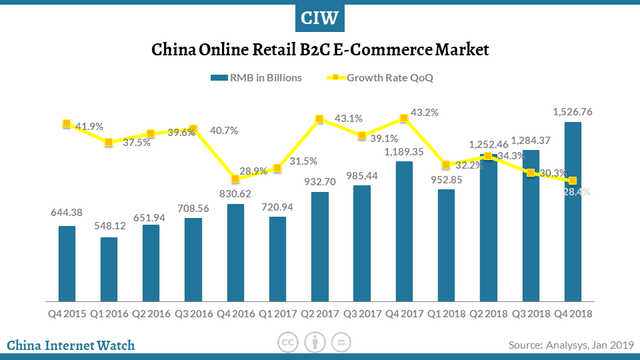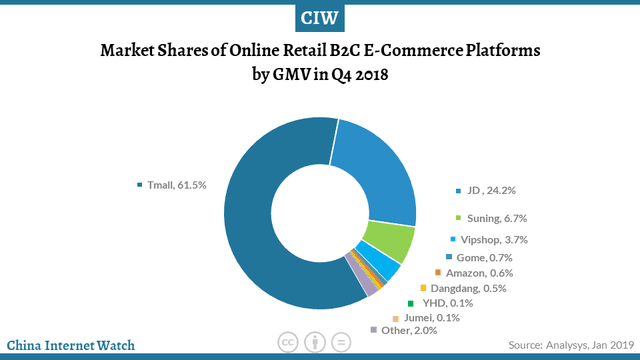What is happening now in e-commerce in Southeast Asia, especially China, can be compared to The Big Bang Theory (not the show). The Chinese market reached over $ 672 billion in 2017, with online sales accounting for nearly 16 percent of total sales. The market is, of course, dominated by subsidiaries of the Alibaba group (Taobao, Tmall, Aliexpress, Fliggy, 11 Main).
Nielsen’s report showed all three components of CCI remained high in the second quarter of the year. Local job prospects (75 points), personal finance (68 points) and the willingness to spend (60 points) continued strong run. China’s GDP growth remained stable in the first quarter, up 6.8 percent year-on-year and 1.4 percent month-on-month, according to data from the National Bureau of Statistics. This impressive growth is currently being characterized by the flocking of new investors from across the world into China. E-commerce growth is, indeed, making business entry to China easy and highly profitable.

If you are just planning to start with e-commerce NOW it’s a good time to hop on the back of the red dragon before it leaves you behind. If you need more convincing, please consider Alibaba’s case study:
Table of Contents
Alibaba Group the e-commerce dominator
Alibaba Group is doing very well in China through its e-commerce online shopping website, Taobao. In fact, the revenue from Alibaba’s core commerce grew by 40% year-over-year to 102,843 million yuan (US$14,958 million) as of Q4 2018. Its annual active consumers on the China retail marketplaces reached 636 million. What the group did was appreciate the powerhouse that social media has become in China and also acknowledge the power of investing in powerful online customer interaction forum. The Chinese consumer values online interactions, be it with fellow shoppers or with customer care teams.

In the same area that Taobao is thriving in, eBay failed terribly some years back. Why so? Well, because eBay insisted on introducing their western culture into Chinese e-commerce, which was a huge blunder. They failed to understand that in China, customers like to interact with a product at a personalized level, unlike in the west where clients don’t really care about the product provided that it comes from their brand of choice.
Things to consider on the Chinese e-commerce market
The Chinese business landscape can accurately be described as a do-it-for-me culture as opposed to America’s do-it-yourself culture. An e-commerce online shopping website must be ready to solve problems for the Chinese for it to make any significant progress. Customers will only spend money on a platform that upholds their culture as opposed to trying to impose new shopping traditions unto them.
Home Depot is a perfect example of why new brands should never think of trying to change the Chinese shopping culture. The highly established shopping platform entered China with big and good intentions of revolutionizing the country’s e-commerce sector and before long, they had closed shop. People could not exactly connect with Home Depot’s marketing strategies because they were presented to them in a foreign culture.
Other Facts about China’s E-Commerce Industry That You Cannot Ignore
If you are a business owner looking to expand to China, you- by far- have made the best decision in your entrepreneurial life. But there are challenges, though. Some of them- e.g. taxes and legal requirements can be handled by your professional employer organization, but others cannot. You will, for example, have to handle all your e-commerce challenges.
Here are a few things that will guide you through the challenges:
- Tmall, Taobao, and WeChat are the biggest e-commerce entities in China. If you can study their models, then you are ready to break into the Chinese market. Tmall, for example, boasts of more than half of all business-to-consumer (B2C) online retail operations in the country. Wait… WHAT?

- China’s online retail market is currently nearing a trillion dollars. That’s more than the UK and US combined, and almost twice as large as America’s. No investor worth his or her salt can ignore such a huge marketing opportunity.
- Mobile-first marketing strategies are extremely important in China because most of the online shoppers use smartphones to place their orders. Social networking is also huge in the country, so you better be ready to provide your shoppers with a cool, mobile-optimized chatting platform. Studies point out that over 14 percent of all shoppers make their shopping decisions after engaging with a seller online.
- Around 25 percent of all online shoppers in China do it via recognized social channels, while 54 percent of them depend on posting reviews. Research indicates that a Chinese online shopper is 71 percent more likely to spend money on a product if it has a strong media presence than those that do not.
- Digital consumers are the majority in China. As you plan your business model, please factor-in this.
Wrapping up:
More and more Chinese are joining the world of internet and online shopping every day and with this trend, the country’s e-commerce possibilities and booming. The online-to-offline (O2O) services in China are big right now, especially in the country’s major cities. In this model, shoppers are able to order services that were traditionally exclusive to offline shopping using their phones. Food delivery, dry cleaning, and transport, among other services have successfully been integrated into online shopping.
Don't forget, sharing is caring! :)

